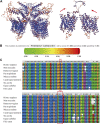Non-syndromic enlarged vestibular aqueduct caused by novel compound mutations of the SLC26A4 gene: a case report and literature review
- PMID: 37745850
- PMCID: PMC10512862
- DOI: 10.3389/fgene.2023.1240701
Non-syndromic enlarged vestibular aqueduct caused by novel compound mutations of the SLC26A4 gene: a case report and literature review
Abstract
Enlarged vestibular aqueduct is an autosomal genetic disease mainly caused by mutations in the SLC26A4 gene and includes non-syndromic and syndromic types. This study aimed to identify genetic defects in a Chinese patient with non-syndromic enlarged vestibular aqueduct (NSEVA) and to investigate the impact of variants on the severity of non-syndromic enlarged vestibular aqueduct. A male patient with NSEVA, aged approximately 6 years, was recruited for this study. The clinical characteristics and results of auxiliary examinations, including laboratory and imaging examinations, were collected, and 127 common hereditary deafness genes were detected by chip capture high-throughput sequencing. Protein structure predictions, the potential impact of mutations, and multiple sequence alignments were analyzed in silico. Compound heterozygote mutations c.1523_1528delinsAC (p.Thr508Asnfs*3) and c.422T>C (p.Phe141Ser) in the SLC26A4 gene were identified. The novel frameshift mutation c.1523_1528delinsAC produces a severely truncated pendrin protein, and c.422T>C has been suggested to be a disease-causing mutation. Therefore, this study demonstrates that the novel mutation c.1523_1528delinsAC in compound heterozygosity with c.422T>C in the SLC26A4 gene is likely to be the cause of NSEVA. Cochlear implants are the preferred treatment modality for patients with NSEVA and severe-to-profound sensorineural hearing loss Genetic counseling and prenatal diagnosis are essential for early diagnosis. These findings expand the mutational spectrum of SLC26A4 and improve our understanding of the molecular mechanisms underlying NSEVA.
Keywords: SLC26A4; compound mutations; non-syndromic enlarged vestibular aqueduct; pendrin; sensorineural hearing loss.
Copyright © 2023 Huang, Li, Pan, Ling, Wang, Huang and Huang.
Conflict of interest statement
The authors declare that the research was conducted in the absence of any commercial or financial relationships that could be construed as a potential conflict of interest.
Figures



Similar articles
-
Identification of novel functional null allele of SLC26A4 associated with enlarged vestibular aqueduct and its possible implication.Audiol Neurootol. 2014;19(5):319-26. doi: 10.1159/000366190. Epub 2014 Oct 24. Audiol Neurootol. 2014. PMID: 25358692
-
KCNJ10 may not be a contributor to nonsyndromic enlargement of vestibular aqueduct (NSEVA) in Chinese subjects.PLoS One. 2014 Nov 5;9(11):e108134. doi: 10.1371/journal.pone.0108134. eCollection 2014. PLoS One. 2014. PMID: 25372295 Free PMC article.
-
Novel compound heterozygous mutations in SLC26A4 gene in a Chinese Han family with enlarged vestibular aqueduct.Int J Pediatr Otorhinolaryngol. 2016 Nov;90:170-174. doi: 10.1016/j.ijporl.2016.09.018. Epub 2016 Sep 17. Int J Pediatr Otorhinolaryngol. 2016. PMID: 27729126
-
Genetic Determinants of Non-Syndromic Enlarged Vestibular Aqueduct: A Review.Audiol Res. 2021 Aug 28;11(3):423-442. doi: 10.3390/audiolres11030040. Audiol Res. 2021. PMID: 34562878 Free PMC article. Review.
-
Hereditary hearing loss with thyroid abnormalities.Adv Otorhinolaryngol. 2011;70:43-49. doi: 10.1159/000322469. Epub 2011 Feb 24. Adv Otorhinolaryngol. 2011. PMID: 21358184 Review.
References
-
- Abe S., Usami S., Hoover D. M., Cohn E., Shinkawa H., Kimberling W. J. (1999). Fluctuating sensorineural hearing loss associated with enlarged vestibular aqueduct maps to 7q31, the region containing the Pendred gene. Am. J. Med. Genet. 82 (4), 322–328. 10.1002/(sici)1096-8628(19990212)82:4<322:aid-ajmg9>3.0.co;2-0 - DOI - PubMed
Publication types
LinkOut - more resources
Full Text Sources

